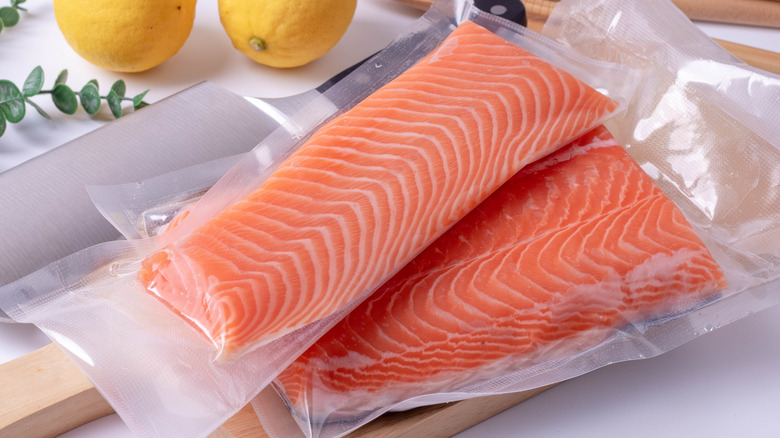How To Safely Defrost Salmon In Your Microwave
We know. Arranging "fish" and "microwave" in the same sentence is about as off putting as "moist" in any context outside of the culinary. Still, sometimes the seafood and kitchen appliance must meet, and defrosting dinner is a prime example. But you can't just zap a salmon fillet and hope for the best. Although you are technically trying to bring the fish's temperature up, it's critical that it doesn't spike too high when defrosting.
The U.S. Department of Agriculture Food Safety and Inspection Service calls anything between 40 and 140 degrees Fahrenheit the "Danger Zone" since this temperature range is ideal for bacteria to multiply. Your microwave's defrost setting or power level button can provide a detour from said Zone. Both modes essentially reduce the machine's electromagnetic intensity. That reduced intensity can help you better control the temperature for safety, as well as keep you from prematurely cooking your food when all you really wanted to do was de-ice it. That way you can go on to grill, sauté, or bake your salmon in the oven as intended, with far superior results. The FSIS also asserts that you must cook the fish immediately after defrosting, lest it carries over any unwelcome and dangerous warming.
More tips for safely defrosting your salmon
If your microwave does have one of those fancy defrost options, it likely allows you to enter the type of food you're prepping and its weight. As long as your microwave is in working order you can count this as diligence done in your temperature controlling efforts. If you've been randomly punching in numbers with a hope and a wish before now, you might notice the difference those easy extra steps can make.
However, microwave defrosting requires a modicum more math if you're working only with power level options. Some manufacturers recommend setting the microwave's power level between 20% and 30% for around eight minutes per pound. That might sound like a long time to run anything through the microwave — and it is — but remember that the power is considerably reduced from the norm. You must also remember to remove any packaging and use only a microwave-safe dish to defrost, whatever button you're going to press. If this all sounds like a little too much arithmetic for what would otherwise be a fairly easy weeknight meal, there are other ways you can cook salmon from frozen.

